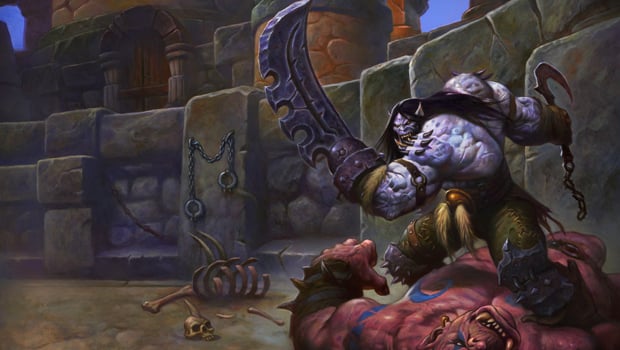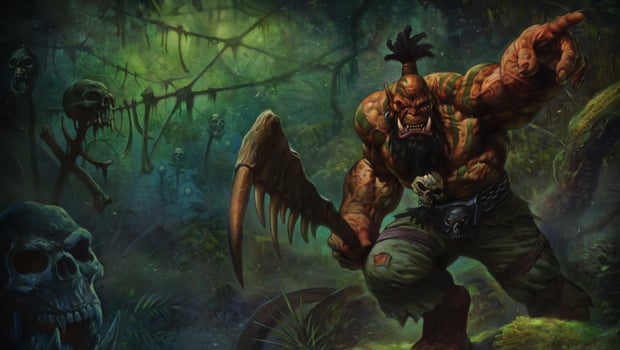Know Your Lore: The differences in Draenor’s Warlords

You know, we spend a lot of time talking about the various Warlords of Draenor as they’re presented in the latest expansion’s version of history. Lords of War was supposedly Maraad’s tales of these old warlords, but the stories were pretty specific. And in some cases — like Kilrogg’s vision of his death — they seemed like a direct reference to the alternate version of Draenor’s warlords, rather than our own. So I thought it would be a fun idea to go ahead and comb through the history of each warlord of Draenor, comparing their history in our version of Azeroth, versus the version presented in Warlords of Draenor. A side by side glimpse into the differences between the history we lived through, and the history we’ve only heard about.
Why? Because it’s pretty apparent that Garrosh’s arrival and his meddling with Grommash’s decision to drink the blood of Mannoroth wasn’t the catalyst for everything that happened on this version of reality. The deck was stacked differently long before Garrosh arrived. And perhaps by looking into this differences and seeing how they fit together, we can try to puzzle out why exactly Kairoz needed this particular version of Draenor … and this particular collection of Draenor’s warlords.
 Kargath
Kargath
Our universe: Kargath Bladefist was in fact one of the original members of the Shadow Council, but that didn’t appear to be a widely-known fact. Although the majority of the orc clans stormed through the Dark Portal during the First War, Kargath remained behind on Draenor. This was apparently viewed favorably, as was Kargath himself — he had an outpost and expeditionary force named after him on Azeroth, as well as Bladefist Bay, just south of Orgrimmar. Chances are, had his involvement with the Council been widely known, his name wouldn’t have been used anywhere.
On Draenor, he was one of the first to hear and agree to Ner’zhul’s plans to open portals and conquer other worlds. When the Alliance raided Draenor after the conclusion of the Second War, Kargath defended Hellfire Citadel alongside the ogre-mage Dentarg, one of Ner’zhul’s most trusted servants. In a clash with the Alliance Expedition Force, Dentarg was killed and Kargath was left to fend for himself. He headed to Garadar to try and recruit more soldiers, but was flat out turned down by Greatmother Geyah — this is also when he met a young Garrosh Hellscream, infected with the red pox. Kargath returned to Hellfire Citadel and at some point signed up with Illidan Stormrage, presided over an enslaved Magtheridon and rose up to rule the Fel Horde — and along the way lost and replaced his other hand with a blade while he was at it.
Draenor: Kargath’s time on Draenor was unfortunately short-lived. What we do know is that he had absolutely nothing to do with the Shadow Council at all — he simply joined up with Hellscream’s Iron Horde at some point and pledged the Shattered Hand to the cause. And despite his supposed bad blood with the ogres, he apparently was okay with the idea of attending an arena at Highmaul — an event that ended with his untimely demise.
The biggest difference between our Kargath and Draenor’s seems to be a combination of intelligence and sheer ambition. In our timeline, Kargath was a ruthless servant of the Horde, and cunning enough to get in on the Shadow Council while it was still being formed. Although he never outright stated any ambitions for leadership, he stepped up to preside over the Fel Horde as Warchief, and was perfectly fine with serving under Illidan Stormrage — likely because Stormrage had turned on the Burning Legion, and Kargath realized at some point that this was a pretty good idea. Kargath was in fact one of the few of the warlords to survive long enough to see Draenor become Outland, survive the destruction, and continue to thrive all the way until we encountered him in Outland. But we don’t see a lot of this cunning reflected in Draenor’s Kargath — he’s content to follow Grommash Hellscream, but his contribution seems to be limited to some incredibly fierce soldiers. And while our Kargath likely wouldn’t have set foot in Highmaul after his escape, Draenor’s version not only visited, but willingly stepped in a pit to have his revenge, only to meet his end in the process.
 Blackhand
Blackhand
Our universe: Blackhand was not only ruthless and deadly, he was a leader. In fact, he was the first Warchief of the Horde when it was formed just before the First War began. A tactical genius and a ruthless dictator, Blackhand commanded the respect and admiration of most of the other clans. Even if they didn’t care for him all that much, the other clans knew exactly what he was capable of. But with great power comes a gigantic ego and a lust for even more power — which worked incredibly well for Gul’dan, who was able to easily manipulate the Blackrock chieftain into thinking he was far more influential than he was. He made Blackhand a faux-member of the Shadow Council in name only, and then made sure Blackhand was elected Warchief of the united clans of the Horde — an easy task, simply because Blackhand was so ridiculously popular.
And as power-obsessed as he was, Blackhand had absolutely no problem turning over all his shaman to Gul’dan and letting them become the first warlocks, letting the warlocks accelerate the age of orc children — including his own. Blackhand led the assault against Karabor, and later led the Horde through the Dark Portal into Azeroth. But his ties to the Shadow Council and Gul’dan eventually spelled his demise. During the First War, when Gul’dan fell into a coma after Medivh’s death, Blackhand’s second in command, Orgrim Doomhammer, decided to step up and take the Horde for himself in an attempt to lead it away from the dark path the Shadow Council had forged. Doomhammer was successful, beheading Blackhand and assuming the role of Warchief and leader of the Blackrock Clan in one decisive action, and leading the Horde to victory.
Draenor: These two tales could not be more different. Blackhand is still the ruthless leader of the Blackrock on Draenor, but his role in the Iron Horde is not as its leader, but as its master craftsman. He used schematics given to him by Garrosh Hellscream to rework the Blackrock forges and create monstrous machinery and weapons the likes of which Draenor had never before seen. It was Blackhand who led the attack against Shattrath City, along with Orgrim Doomhammer, who still served as second-in-command. But in a twist of fate, it was Doomhammer who met his demise at the hands of Blackhand on this world.
Once again, the biggest difference here seems to be a matter of motivation, but a large part of that had to do with Gul’dan’s influence, or lack thereof. Blackhand was still incredibly cunning and perhaps a tactical genius, but he was never fostered to believe he could lead the Horde — Gul’dan never got the chance to convince him of this before Grommash’s intervention. But his ego remains firmly intact on both worlds, and played no small part in his demise on both. On Draenor, it was simply a matter of time before we stormed the Foundry and put an end to Blackhand once and for all.
 Kilrogg
Kilrogg
Our universe: Kilrogg Deadeye served as leader of the Bleeding Hollow in our timeline, and was one of the first to drink the blood of Mannoroth after Grom Hellscream. Kilrogg was an older chieftain, and traveled through the Dark Portal at the onset of the First War, where he worked first for Blackhand, and then for Doomhammer after Blackhand’s death. He and the Bleeding Hollow managed to escape after the Horde’s defeat at the end of the Second War, and actually successfully returned to Draenor. From there, he agreed to join Ner’zhul and help him complete his plans to open portals to other worlds — and Ner’zhul took on Kilrogg and his clan as his bodyguards. This would end up spelling Kilrogg’s demise. On the way from Hellfire Citadel to the Black Temple to begin the portal ritual, Ner’zhul and his bodyguards stopped in Auchindoun, where they were confronted by Alliance soldiers. Although Kilrogg managed to buy Ner’zhul enough time to escape, he found himself face to face with force commander Danath Trollbane, who challenged the orc to a duel and won. Kilrogg never lived to see the ritual completed — or the destruction the portals caused when they tore Draenor apart.
Draenor: We don’t actually know a lot about the Kilrogg of this timeline, because our encounter was limited to one very short spat during the first conflict in Tanaan Jungle. Presumably we’ll see plenty more of Kilrogg in patch 6.2, particularly given the cinematic at the end of the current leg of the legendary questline.
This is what we know of the Bleeding Hollow — they were at war with the arakkoa, and nearly defeated, when Kilrogg took matters into his own hands and performed a dark ritual. This ritual showed him a vision of his own death, somewhere in the future. In our timeline, perhaps it was the death by Danath that he witnessed, but in Draenor’s timeline, presumably he saw himself fighting both Alliance and Horde in Hellfire Citadel. And he also saw himself riddled with fel blood, which would explain why he so agreeably took Gul’dan’s offered gift of demonic blood and drank it without a second thought. In both cases, the reason Kilrogg is a good leader is because lacks that uncertain fear of the future — he knows enough of the future to know when and how he’s going to die. And until he sees that day, he can remain confident in the fact that whatever happens, whatever decisions he makes, he’ll survive until he finally witnesses the events he’s already foreseen.
For these three warlords, life — and death — have turned out very differently than their original timeline counterparts. But the majority of these differences all link to three key players, whose destinies have been changed irrevocably, and possibly hold the key to Kairoz’s fascination with this particular iteration of Draenor. Next week, we’ll take a look at Ner’zhul, Gul’dan and Grommash Hellscream, then and now — what changed, what possibly could have caused those changes, and why their world was the most ideal setup for the machinations of a bronze dragon whose ultimate motivations have yet to be fully realized.
Please consider supporting our Patreon!
Join the Discussion
Blizzard Watch is a safe space for all readers. By leaving comments on this site you agree to follow our commenting and community guidelines.
 @Shadesogrey
@Shadesogrey




